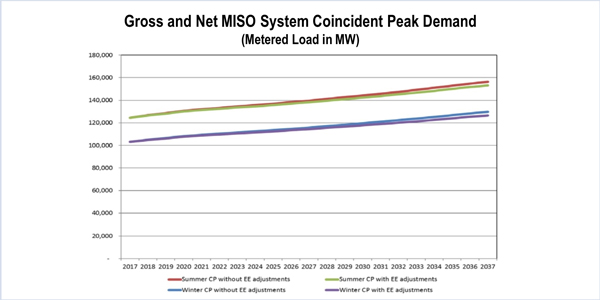By Amanda Durish Cook
MISO is surveying how to get more information from load-serving entities to create a more detailed load forecast for transmission planning, though stakeholders continue to question the feasibility of the plan.
MISO Senior Policy Studies Planner Temujin Roach said the RTO wants to try “bottom-down” load forecasting, where it relies on data compiled from LSEs to form the basis of its load forecast that informs transmission buildout. For that, MISO’s 140-plus LSEs will have to annually assemble four different 20-year load forecasts to fit with each of the RTO’s four future scenarios developed for the Transmission Expansion Plan. (See MISO Looks to Align Load Forecasting, Tx Planning.)
The approach is one of two MISO is vetting to improve its load forecasts. If LSEs decide they cannot collect that level of information, the RTO will continue its practice of hiring a contractor to put together a load forecast. In that case, Roach said the level of specificity would not be as detailed, though the contractor would take any load information LSEs provide on a voluntary basis. MISO currently uses Purdue University’s State Utility Forecasting Group to create an independent load forecast; the forecast is not based on any of the MTEP future scenarios.
MISO has a survey out until April 12 asking LSE owners how feasible it is to put such forecasts together and how much it may cost LSEs to assemble detailed load data.
“For some, it’s negligible so far, and for others, it may be a burden,” Roach said during a special March 21 conference call on improving MISO’s load forecast.
“What we’re looking for from load-serving entities is if this is information they already have, or if they’re willing to provide it,” Roach added.
Stakeholders asked what share of LSEs had to participate in the forecasting before MISO would pursue the new approach. Roach said he didn’t know.
“We’re looking for a feel of who has got problems with it and how feasible it is — most specifically it’s the small munis and co-ops that might not have the ability to forecast already in place. … We’d be willing to work with them and make this as painless as possible,” Roach said. “I don’t have an answer. It depends on who is struggling with it, and how big their loads are. We need more information to make … a prudent decision.”
Stakeholders Skeptical
Several stakeholders said they still weren’t convinced MISO had put enough thought into how it would align 140-plus disparate data sets into a cohesive load forecast.
Minnesota Public Utilities Commission staff member Hwikwon Ham said that LSEs don’t understand how MISO expects them to adapt their base-case loads to fit into the “limited fleet change,” “continued fleet change,” “accelerated fleet change” and “distributed and emerging technologies” MTEP futures.
Roach said MISO would most likely hold workshops and develop a Business Practices Manual to describe how to approach the data.
“I’d like to hitch onto [the] exasperation,” said WPPI Energy’s Steve Leovy. “I don’t know how to provide what MISO is asking, because I don’t think the data question is adequately specified. I don’t think multiple LSEs have the same idea about it.”





